#3 in the series.
Today was our first day at work! Yesterday we “shadowed” and learned the ropes for the Bears Ears Education Center (BEEC). But today our fearless leader Kirsten worked in the back office, always within reach for fielding questions that we couldn’t answer for visitors.
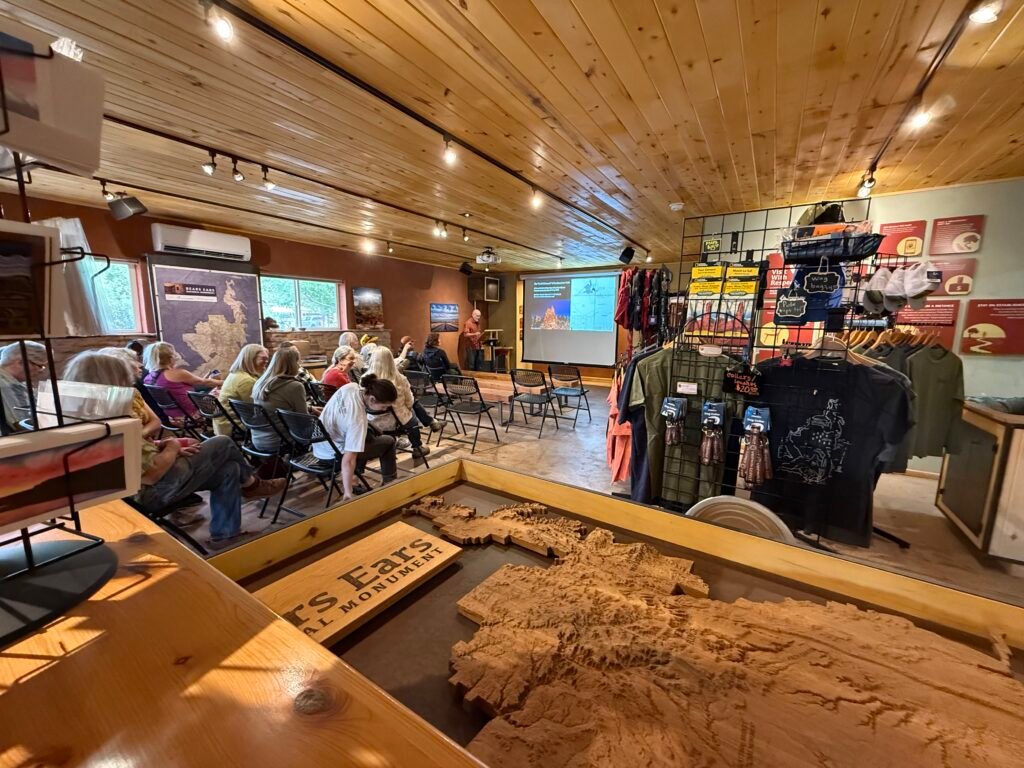
We supported (and listened to) an excellent presentation by archaeologist Kenny Winch. He discussed the archaeological significance of the region around Four Corners and the need for “durable protection.” About 30 people attended the event.
The BEEC sits on US191 near the middle of Bluff, UT. There’s a good bit of traffic from folks sight-seeing the nearby areas such as Monument Valley, Canyonlands, Arches, and other well-known places. But Bears Ears is not well-known, and the BEEC is in a good location to help out. It’s a fantastic facility with a nice selection of books and merchandise.
There is an outdoor native plant garden and a couple of camping spots for volunteers like us. They don’t mind helping the wayward traveler and are always ready to provide a place to rest or water-up, as well as point out local restaurants and attractions.
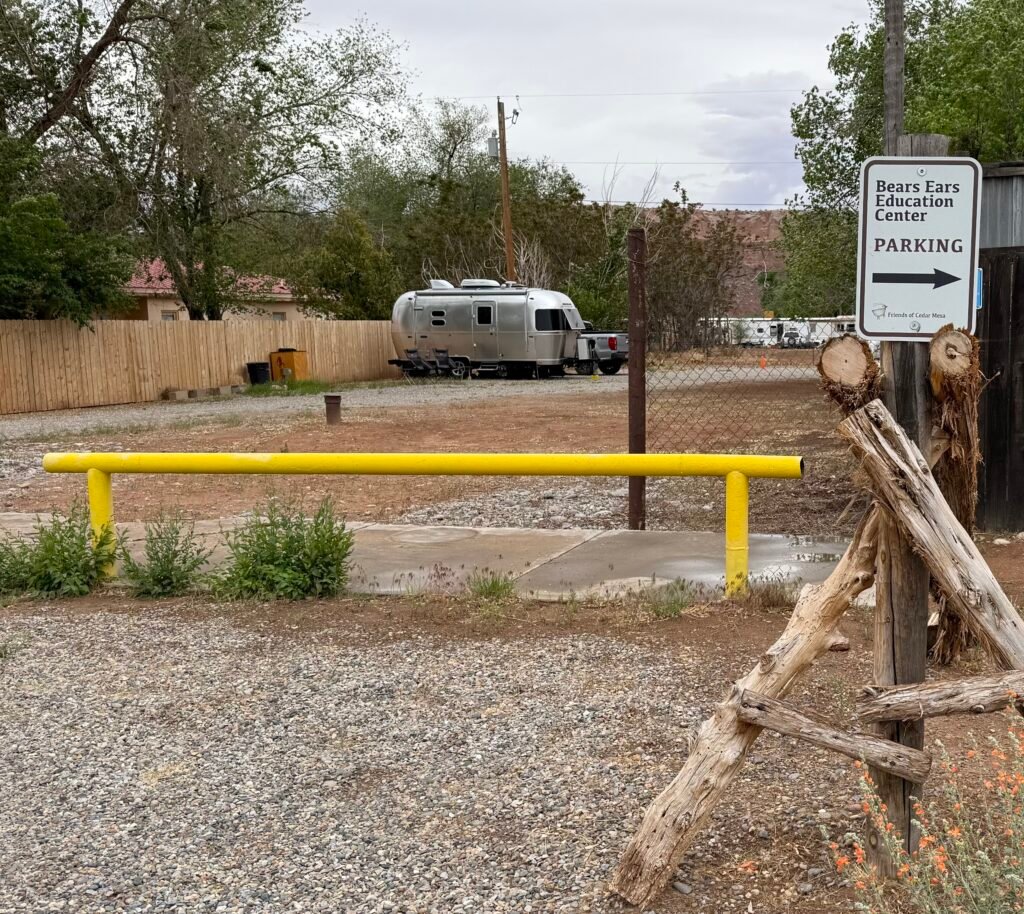
You can find out more here: https://bearsearspartnership.org/education-center
Now, while many of the visitors stop by to find out where to explore, the primary goal of the BEEC is to explain how to explore. Bears Ears is public land, but it is also chock-full of ancestral structures and rockart that date back thousands of years! So helping visitors understand the significance of the many sacred sites and how to respect them properly is a major theme. Most of these concepts are straightforward and include things like staying off the structures, or not touching the rockart. Some are maybe not so obvious, such as keeping pets away from sensitive ruins (they dig and pee) or packing out your poo (the desert is too dry to break it down).
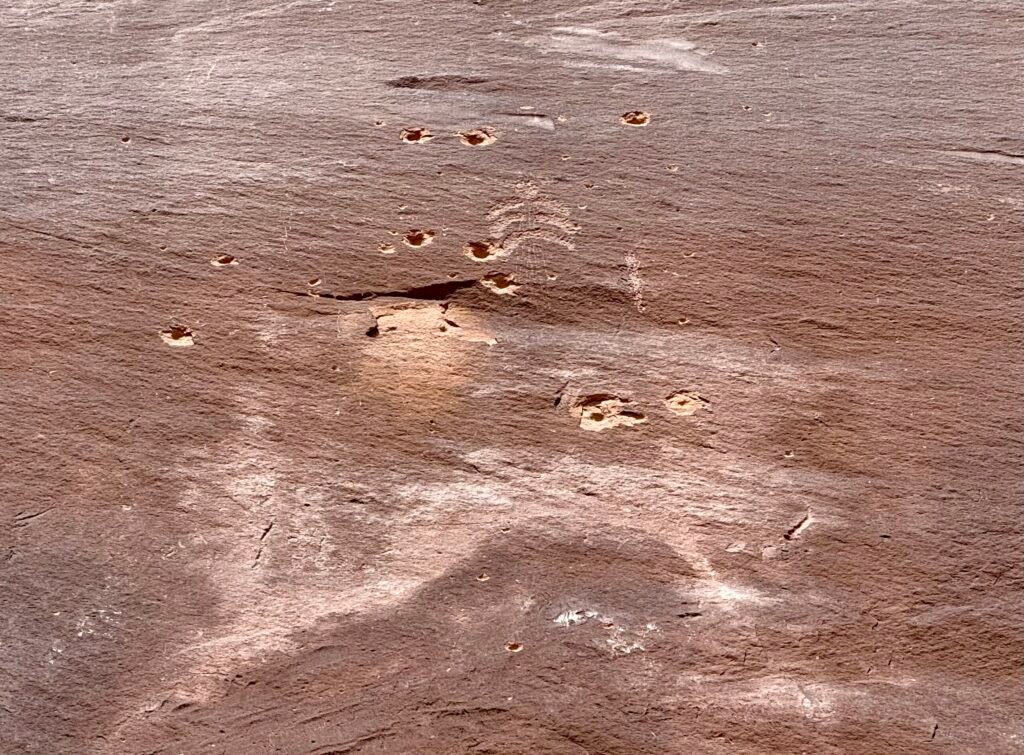
Visitation is up, and as we have begun to visit some of the sites that are more easily accessed, we understand the need. Defaced rockart with names, initials or even bullet holes are easily seen.
We should do better. Plainly out of respect, but also for future discoveries, and so that our children can experience these amazing things too. Education is the key.
And this leads us to the other main part of our involvement as volunteers, becoming ambassadors for Visit With Respect (VWR), which I will come back to after a little more explanation.
Bears Ears is the first time a coalition of federally recognized Tribes has asked the government for area protection. In July of 2015, leaders from the Hopi Tribe, Navajo Nation, Ute Mountain Ute Tribe , Pueblo of Zuni, and Ute Indian Tribe founded the Bears Ears Inter-Tribal Coalition, there are 30 tribes supporting the effort now. The tribes began developing a land management plan for 1.9 million acres that contains literally thousands of ancient sites and communities. President Obama formed the national monument in 2016 consisting of 1.3 million acres. The Trump administration reduced it to 300,000 acres in 2017, but President Biden restored it in 2021. Now the area is threatened again.
What’s the big deal?
The General Mining Act of 1872 was signed into law by President Ulysses S. Grant over 150 years ago in an effort to motivate people to move west and develop its resources. For a price ranging from $2.50 to $5.00 an acre, anyone over the age of 18 that locates valuable minerals on public lands can stake a claim.
And I say can because this ancient law is still on the books in its original form! Any public land that is not being “used” for other purposes can be claimed if minerals are found. So an area much greater than the original 1.9 million acres between Capitol Reef on the west and Mesa Verde to the east is vulnerable.
In 1990 a company based out of Canada used this law to buy land along Yellowstone National Park for gold mining. They estimated over $600 million worth of minerals could be extracted. It was a serious threat, with obvious environmental concerns, and the impact to the famous geysers being a prominent issue. In 1996, President Clinton worked out a settlement to buy the land back for nearly $63 million dollars. And in 2010, the deal was finally completed, protecting the area.
So anyone can make a claim and get the land practically free, and then walk away when it doesn’t “pan out,” leaving taxpayers with the environmental mess and loss of resources and beauty.
For the unprotected public lands to the east of Bears Ears, a potash company is already staking it out.
Does this seem smart to you? To allow large corporations to take our public land for next-to-nothing in the hope they can make a go of it? Seems we should do this differently a century and a half later. The craving for resources will never end, and if we want anything at all left for our descendants, we need to change how we think and change the laws.
The Visit With Respect approach doesn’t address the issues with the law, it tries to instill a sense of respect for you and me. In this way we can always enjoy these amazing places and continue to learn from the people that lived here long ago. But especially, respecting the indigenous tribes that live here today. You can find out more here:
https://bearsearspartnership.org/visit-with-respect
Hopefully this provides a good idea of what the Bears Ears Partnership is about. They are involved in much more, so I encourage you to check them out: https://bearsearspartnership.org.
We will start our ambassador training tomorrow. One of the exciting prospects is the encouragement to go and visit many of the places within Bears Ears so that we can share effectively with visitors.
And we are just getting started…
Sand Island
Sand Island is a popular access point on the San Juan River. A primitive campground and a relatively new river trail are there too, but it’s also home to possibly the oldest rockart in North America! Rockart appears in two general forms: Pictographs, where pigments and dyes color the rock like a painting; and Petroglyphs, where images are pecked or cut into the rock itself.
Sand Island has two sections, or “panels” on either side of the boat ramp. It’s easy access and well worth a stop if you are driving through. The downriver panel is amazingly dense! There are so many figures on the wall. In the before/after slide that follows, I’ve used some filtering to try and expose that in just one little area. Super cool.
Because of all of the cultures that have lived in Bears Ears over time, archaeologists have their work cut out for them in determining the age in which artwork was created. Styles and the sophistication of the images are one way. Another is seeing which animals are being represented. For example, images of horses indicate images created after the Spaniards arrived. Yet another is the “patina.” The sandstone surface will stain over time from rain, sun and minerals. In more recent carvings (and bullet marks) the patina has not re-covered the stone. So the oldest carvings have become faint under the later patina and are harder to see.
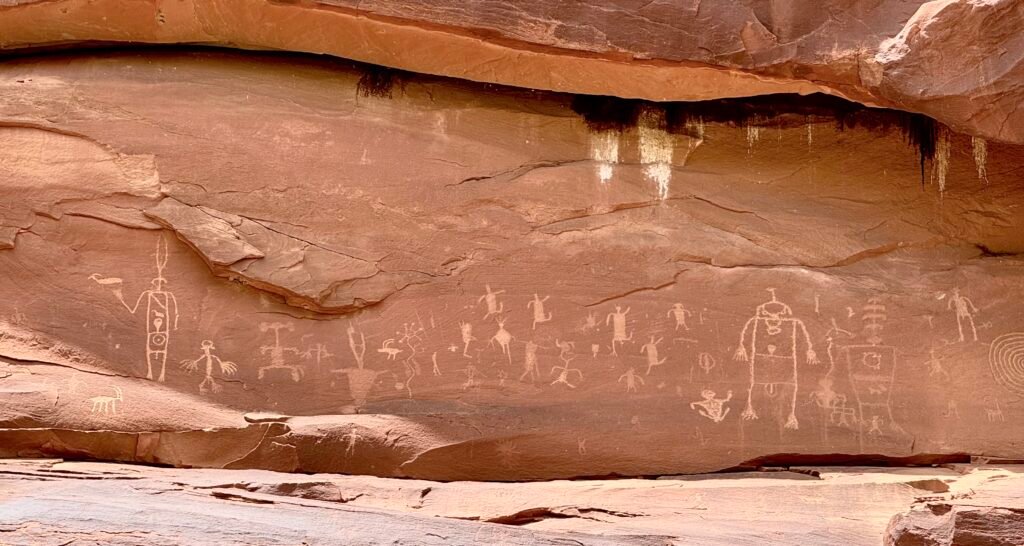
At the BEEC, I was intrigued with a display showing a bison and a…mammoth! It’s estimated to be more than 10,000 years old. That’s just crazy! Kirsten mentioned it was on the upriver section so we went looking. It took us a couple of times, but we finally located it. In the before/after slider to follow, I’ve identified characteristics that make it easier to see.
Just too cool.
Tomorrow, we are going to try and find San Juan Hill and the River House. Hopefully the deep sand won’t be too much for the Ranger…


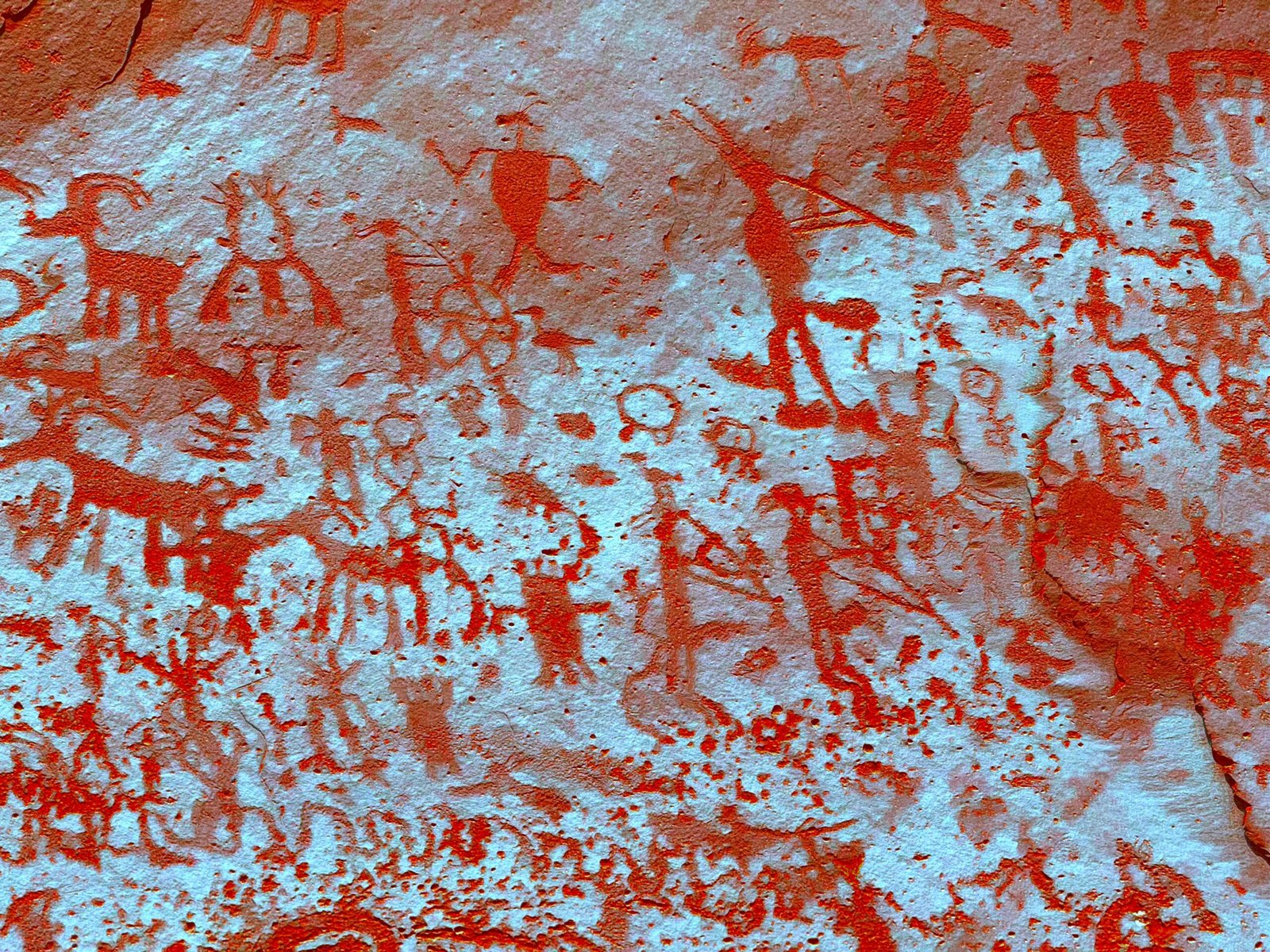

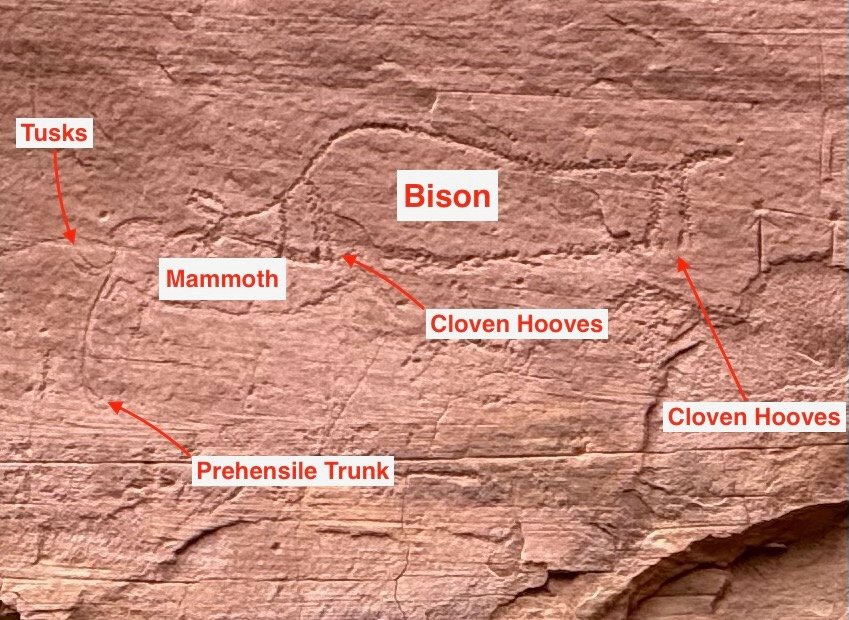
Leave a Reply